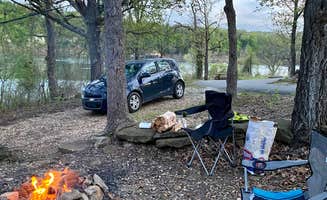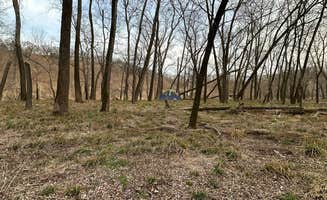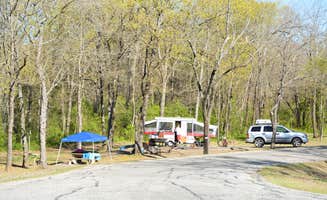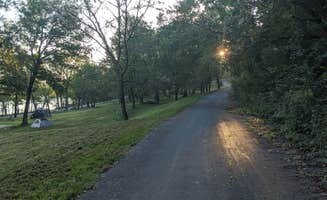Tent camping near Sallisaw, Oklahoma provides access to the western edge of the Ozark Mountains with elevations ranging from 500 to 800 feet above sea level. This eastern Oklahoma region receives approximately 45 inches of annual rainfall, creating lush forests dominated by oak, hickory, and pine trees. Most primitive camping areas in this region close during winter months (November-February) due to unpredictable weather conditions.
What to do
Kayaking at Lake Tenkiller: Explore the clear waters of Lake Tenkiller from Eagles Point — Tenkiller State Park. The lake offers excellent conditions for paddling with multiple access points. "The lake was perfect for kayaking. I actually fell out of the kayak at this place. The water was really clean and clear," notes reviewer Kevin T.
Mountain biking near Fort Smith: Just 30 minutes from Sallisaw, the COE John Paul Hammerschmidt Lake Springhill Campground offers extensive trail networks. A camper reports, "There are great trails on site for mountain biking or hiking. I saw deer, a snake, and what looked like a coyote on the trail."
Bird watching at Horseshoe Bend: The Illinois River corridor attracts numerous bird species year-round. "This is a bird watcher's paradise, and we saw a lot of people fishing. I was able to see multiple species of Oklahoma's woodpeckers, some birds of prey, and many songbirds," writes Rachel R. about her visit to Horseshoe Bend.
What campers like
River sounds at Natural Dam: Located 25 miles east of Sallisaw, this site features a small waterfall that creates pleasant ambient noise. "We found this quiet spot with a small waterfall on Mountain Fork Creek that has a fairly large (semi-level) gravel parking lot right next to the natural waterfall which gives good noise cover for the road nearby," notes one reviewer.
Spacious sites at Springhill: The sites at COE John Paul Hammerschmidt Lake Springhill Campground offer exceptional privacy. "This is a great COE campground with spacious sites. I had site B09 which was far away from any other sites, had good shade, and had a view of the river," reports Jennifer L.
Creek-side camping at Gates Nature Preserve: Tent sites positioned along flowing water create a peaceful atmosphere. One camper shares, "Our little campsite was so cozy with a table, a fire pit and a grill. It was right next to the creek! The morning walk to the camp house was lovely because on the way there, we passed a herd of adorable cows."
What you should know
Seasonal water levels: Spring flooding can affect campsite availability at waterfront locations. At Hickory Flats — Tenkiller State Park, campers should check water levels before arrival. One visitor noted, "The park is LARGE. The plus to that is despite busy holiday weekends, spring flooding or special event weekends, you can always find a place to pitch a tent."
Primitive area regulations: Some areas have changed their camping policies. At Horseshoe Bend, a camper reported, "We did camp there in a tent for one night, but were politely told by a game warden the next day that, though it used to be open for that, it is no longer allowed. There are still signs up showing tent camping, but they are apparently inaccurate."
Road conditions: Many primitive sites require careful navigation. "Definitely bring a 4x4, and check the weather. Dirt road was rough, but a camaro managed to get through somehow the morning we left," warns Sydnee L. about Horseshoe Bend Primitive Public Use Area.
Tips for camping with families
Playground access: Eagles Point — Tenkiller State Park offers several family-friendly amenities. "It has a marina a boat dock a floating restaurant a volleyball court hiking trails a fishing dock plenty of wildlife restrooms showers playgrounds nature center gift shop," explains one comprehensive review.
Nature programs: Tenkiller State Park hosts regular ranger-led activities for children. "We checked out the nature center, the main hikes and of course some good old campfire fun. Only complaint is you can definitely hear the traffic, so it's not a full escape," reports Lynzie T.
Wildlife viewing opportunities: Many campgrounds offer chances to spot local fauna. "I was able to see multiple species of Oklahoma's woodpeckers, some birds of prey, and many songbirds. Go during the day! Still worth it, even if you camp elsewhere," suggests Rachel R.
Tips from RVers
Leveling challenges: Many sites in the region require careful setup. At Natural Dam, one RVer notes, "We spent the night in the parking lot in our Sprinter Winnebago Revel van. The view, sounds and feels of the natural dam are stunning, relaxing and cool. It stormed at night but we were on the right side of the dam in case it flash flooded."
Water and electric access: Full hookups are limited in the area. One RVer at Springhill Campground reports, "Stayed in campground B $20 for the night with water and electric hook ups. Sites are large with flat paved parking pad. I saw a variety of all sizes of rigs and some tents."
Cell service considerations: Connectivity varies significantly across the region. "Starlink and Verizon very spotty here," notes one RVer about Natural Dam, while another reports, "Cell service was excellent with AT&T and Verizon" at Springhill Campground.





